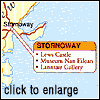|
Skye And The Western Isles
Skye
As you look around Portree or Dunvegan there is no
doubt that, despite its unpredictable weather, tourism is Skye's main industry. From
Kyle of Lochalsh there are two main access points to the island using the ferry from
Kyle or via the new road bridge which sweeps from a western tip of the mainland to
a point just outside Kyleakin. Further south, taking the famous 'Road to the Isles'
from Fort William to Mallaig, you can cross to Skye by ferry to Armadale and land
on the southern spur of the island.
The railway reached Kyle of Lochalsh in 1897 and, since then,
the journey to and 'over the sea to Sky' has been a relatively easy one. The new
road bridge, opened in autumn 1995, from Kyle of Lochalsh via the tiny island of
Eilean Ban, is the biggest balanced cantilever bridge in the world at 820ft (250m).
The Gaelic name for Skye means 'Island of Mist' which most visitors will find apt
at some time during a stay. Often several weather conditions will occur in one day
so it is best to be prepared for whatever the elements decide.
The south

In years gone by travellers came to know Kyleakin,
the first village immediately on reaching the island's easternmost peninsula, by
simply driving through it on their way to better known places or by queuing for long
periods waiting to board the ferry back to the mainland. There is a twelfth century
castle visible from the road on a rocky knoll by the water's edge at the entrance
to the harbour that can be reached by walking along the beach or clambering over
the rocky peninsula.
A round-about marks the land-fall for Skye Bridge
traffic. There is an excellent little restaurant just beyond called the Crofters
Kitchen with a gift shop and licensed bar.
Around Broadford
Eight miles (13km) on along the A850 is Broadford,
the island's second largest community. At the north end of Broadford there is an
unusual attraction at the Old Mill, a stone croft-type building signposted as the
Serpentarium. Inside is a collection of snakes, lizards and frogs including the uniquely
marked Poison Arrow frog from the owner's private collection. He keeps a further
200 snakes at home.
If you take a left on the A881 travelling south-west
you will come upon the villages of Torrin and Elgol. The reason for this diversion
along a single track road is to appreciate one of the best views of the Cuillin Hills.
From the beach at Elgol, looking over Loch Scavaig, the great ragged dimensions of
these sturdy peaks can be clearly surveyed. There is a small boat that crosses to
Loch Coruisk at the foot of the range at least twice a day through the season. As
long as the weather is reasonable, the trip is very impressive.
Returning to the A850, 7 miles (11km) north-west of
Broadford near Luib, you come upon a traditional thatched cottage which is furnished
in a turn of the century style that was indigenous to the Highlands and Islands of
that time. The Old Skye Crofters House also contains some interesting newspaper clippings,
dating from the mid 1800s, when the government attempted to clear the island's small-holders
and make way for sheep and hunting sports. The 1886 Crofting Act gave legal tenure
and some rights to the local crofters.
Armadale
Many visitors choose to approach Skye from the more
southern mainland port of Mallaig, crossing the Sound of Sleat to Armadale. The A851
then carries north to Broadford. There is a good knitwear and gift shop on the Armadale
Pier called Ragamuffin selling hand knits, original cotton clothes, pottery and jewellery.
Only half a mile from the pier at Armadale is the
Clan Donald Centre, its building adjoining the ruins of Armadale Castle. As well
as an opportunity to trace your family roots and learn about the old clan system,
the centre gives an excellent introduction to Skye and the Western Islands. Armadale
Castle was built in 1815. It is surrounded by 40 acres (16 hectares) of mature gardens
from which there are fine views over the Sound of Sleet.
Portree
Portree is the island's commercial and administrative
centre. It was originally known as Kiltaragleann (the church at the foot of the glen)
but gained its present title of Portree or Port Righ, meaning the King's Harbour,
when James V landed in 1540. Here he tried to unite the bickering clans of the MacLeods
and the MacDonalds and also to enlist them to his cause.
The most interesting part of Portree is its harbour.
People tend to hang out there enjoying the boats or taking a walk up to the Lump,
a headland overlooking the bay where they can admire the little cliff-side gardens
or take advantage of the best photo-spot of the harbour. This was the site of the
local gallows where condemned prisoners were ushered from the jail house, now the
tourist office, to meet their fate.
The Royal Hotel above the harbour is said to contain
the room where Bonnie Prince Charlie bid his farewell to Flora MacDonald following
his defeat at the Battle of Culloden in 1746.
On the Sligachan Road you find Skye's Heritage Centre.
This is one of the newest and best of such exhibitions of Highland and island life
with a dramatic and convincing narrative delivered on multi-lingual headsets and
based around Skye's history. There is also a very good restaurant and gift shop.
On the north side of town is the Skye Woollen Mill
and Coffee shop.
The Trotternish Peninsula
The Trotternish Peninsula stretches above Portree
for about 25 miles (40km) to Rubha Hunish and is one of the island's largest and
most remote sections. The Old Man of Storr stands like a giant's bowling pin, perched
on the side of the hill. It stands 160ft (49m) tall and is part of a landslip that
has created several unusual stacks in this area. It is possible to hike to the base
of the Old Man of Storr but scaling the stack itself is left only to those with plenty
of experience.
Towards the shoreline below the Old Man of Storr,
an incredible haul of silver broaches, bracelets and other jewellery as well as tenth
century coins was uncovered in 1891. This may have been a Norse treasure-trove, and
can now be seen as part of the Royal Antiquities Museum of Scotland in Edinburgh.
The A855 and A856 form a long 49 mile (79km) loop
from Portree and back again via Uig and the western side of the Trotternish peninsula.
There are expansive views all along this road to the
Applecross peninsula, backed by the ranges of Torridon with the islands of Rona and
Raasay in the foreground. At Flodigarry beyond the village of Staffin is the home
of Flora MacDonald during her married life from 1751 to 1759. There is a minor road
from Quiraing Lodge near Staffa leading to the Quiraing, an eerie set of pinnacles
and table top formations that are best experienced on foot.
At Duntulm on the western side of the peninsula stands
the wreck of Duntulm Castle, once a MacDonald stronghold from where they attempted
to control the Hebridean clans during the sixteenth century. A few miles south is
the community of Kilmuir and just before it is a cemetery where Flora MacDonald lies
buried.
The Skye Museum of Island Life is nearby, a group
of thatched cottages with farming implements and memorabilia. The spot where Bonnie
Prince Charlie was hidden is near Monkstadt House just above the ferry port of Uig.
The west
From Borve it is possible to drive back into Portree
or turn west towards Skeabost and Dunvegan. The Skeabost Hotel on the River Snizort
has a challenging little 9 hole golf course. It also offers fishing and is a good
place to stop for lunch.
 From the car park of Dunvegan Castle, the first impression
is of a gray-green medieval tower block sitting on top of a craggy rock. The earliest
part of Dunvegan Castle dates back to the ninth century and the present structure
has some fourteenth century sections although there have been many additions and
alterations. From the car park of Dunvegan Castle, the first impression
is of a gray-green medieval tower block sitting on top of a craggy rock. The earliest
part of Dunvegan Castle dates back to the ninth century and the present structure
has some fourteenth century sections although there have been many additions and
alterations.
Access into the castle in those days could only be
gained from the seaward side. From here the warships of the MacLeod's sailed to control
the Western Isles, similar to their Viking predecessors. The castle remains the seat
of Macleod of Macleod and has been continuously inhabited for some 750 years.
There is a small jetty near the castle's southern
flank where boat cruises set off to see seals on the little islands of Loch Dunvegan.
It is possible to walk out on the rocks and get a better overall impression of Dunvegan's
secure position and there are also several acres of castle gardens to explore.
From Dunvegan a minor road leads across the Durinish
Peninsula to the western shores of the island on the Little Minch with views over
to North and South Uist on the Western Isles. The A863 carries on towards Sligachan
and Sconser where you can turn north to Portree or south to the ferry or bridge at
Kyleakin.
|


